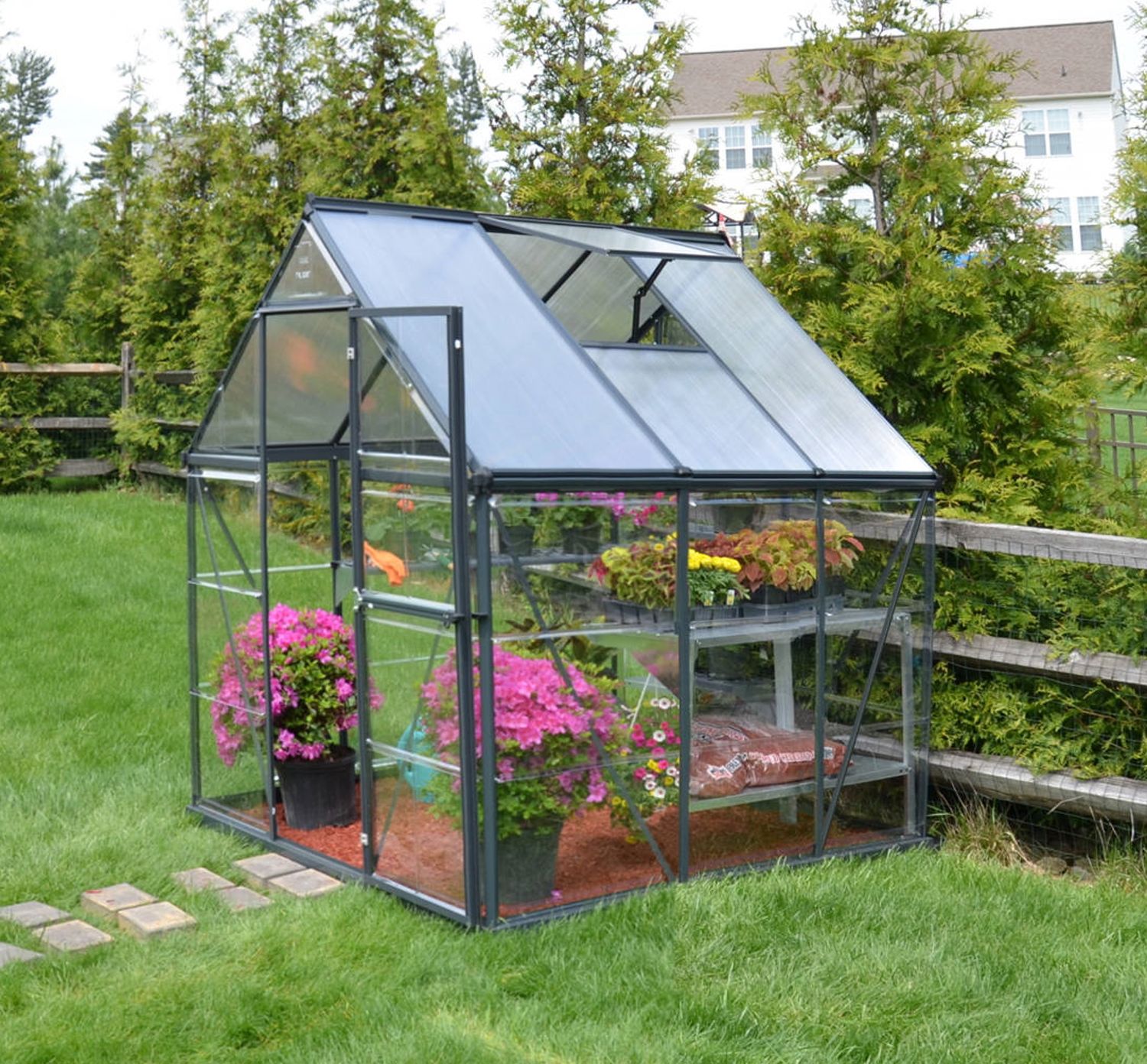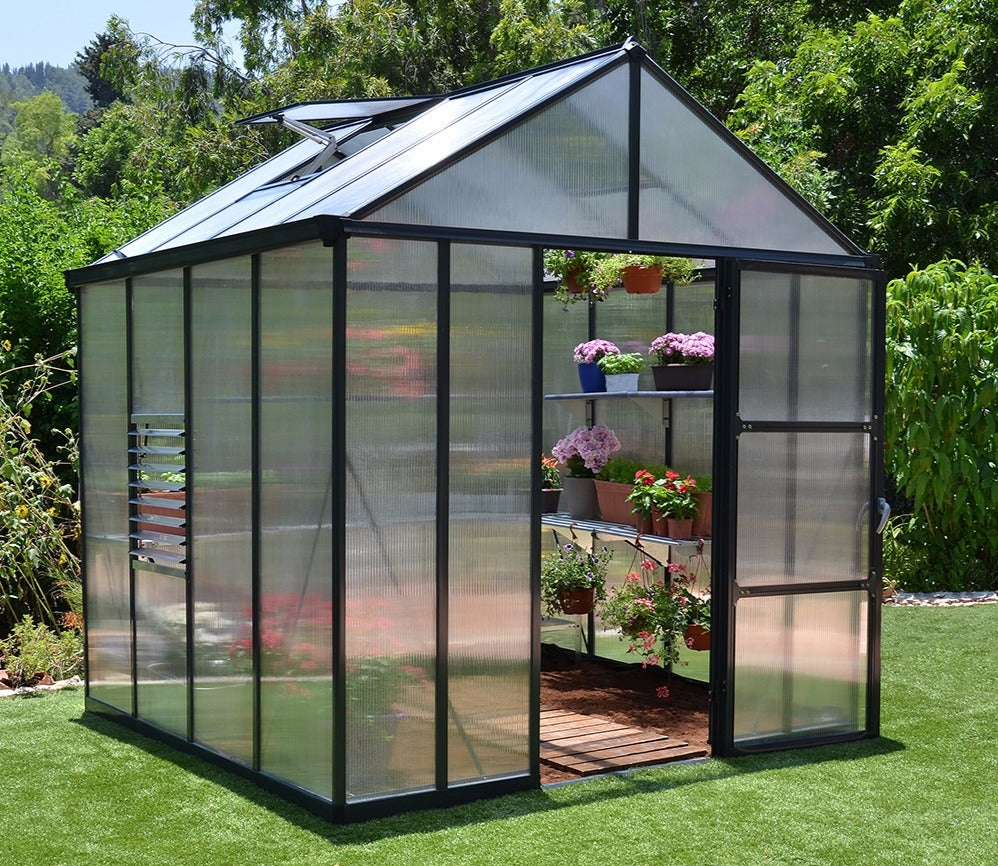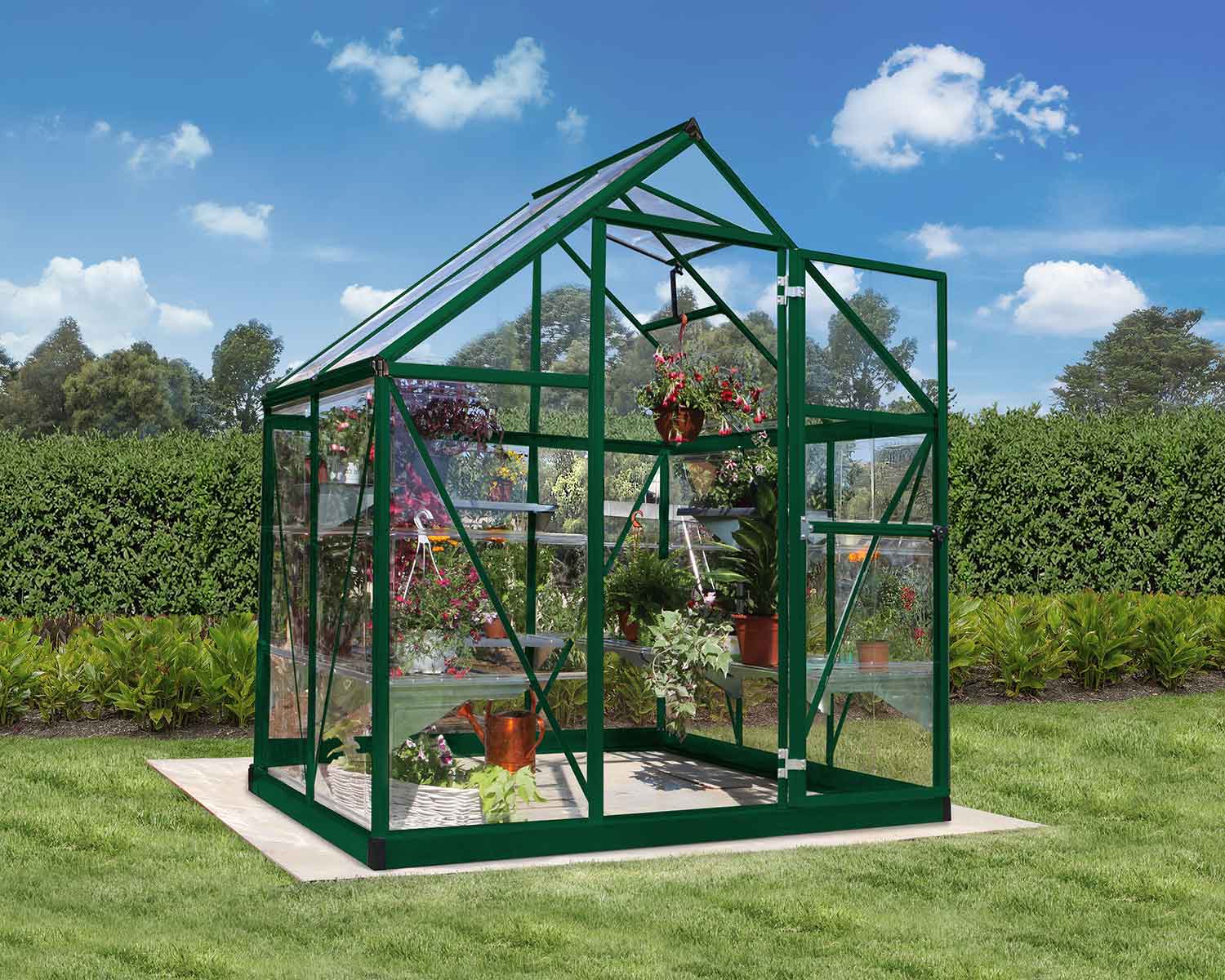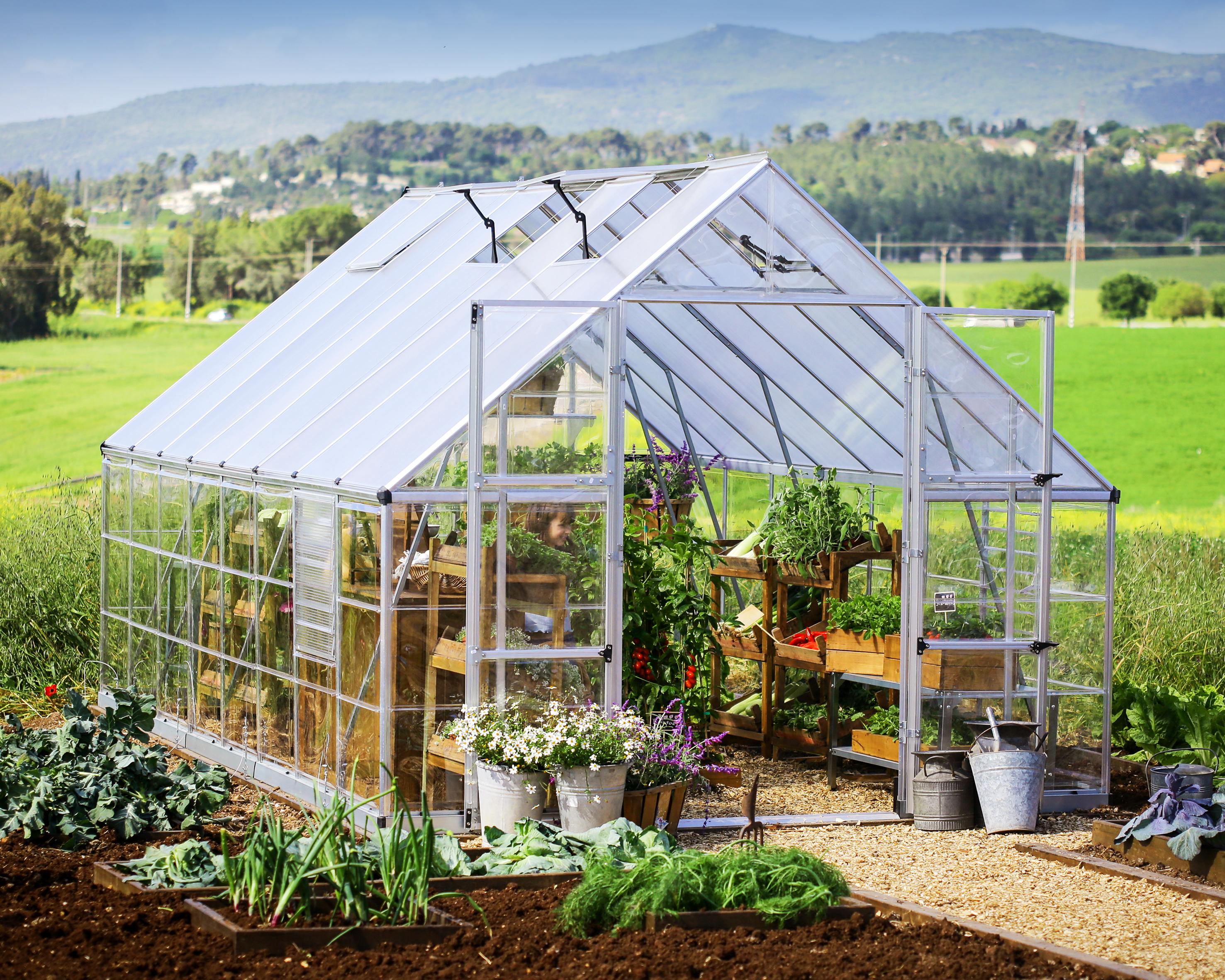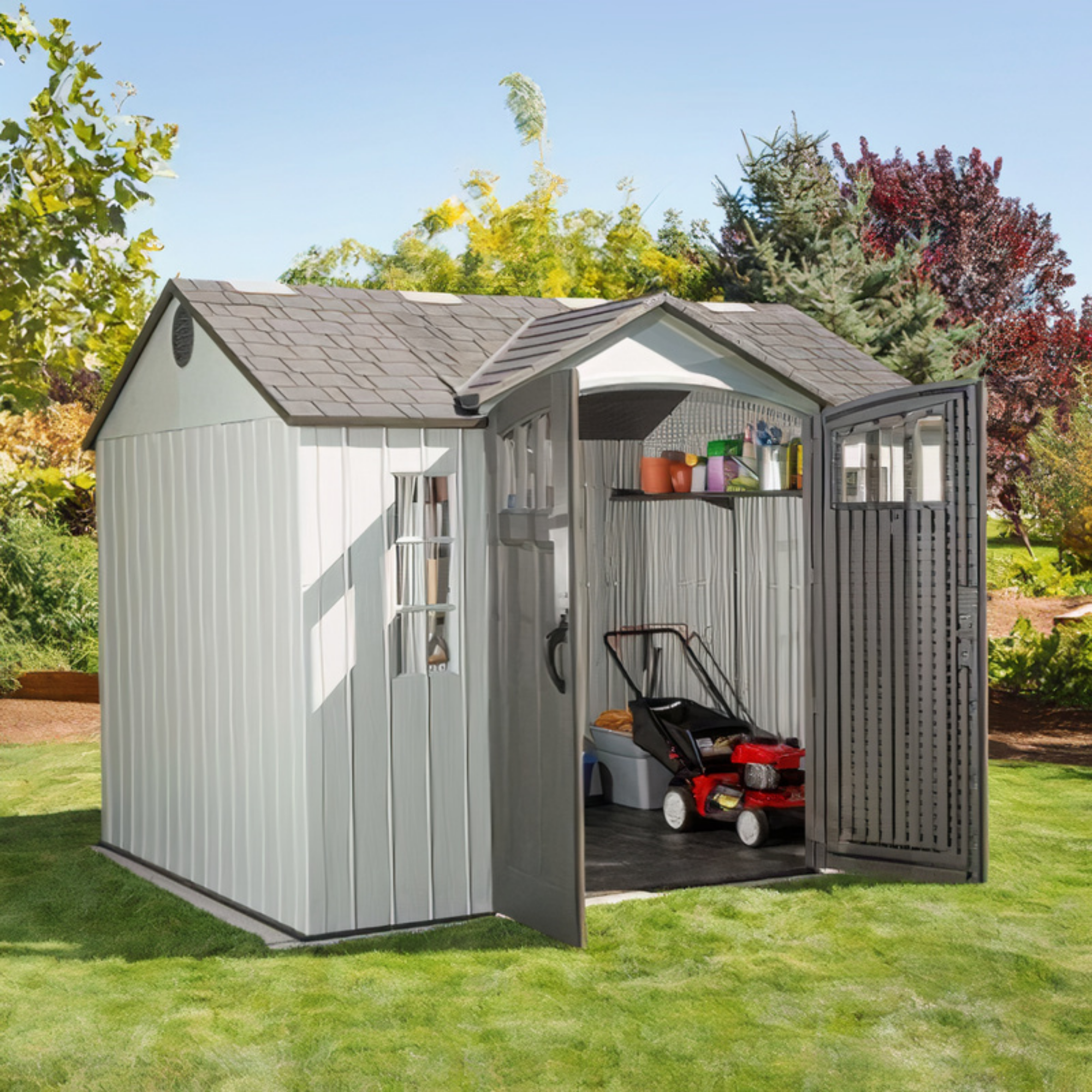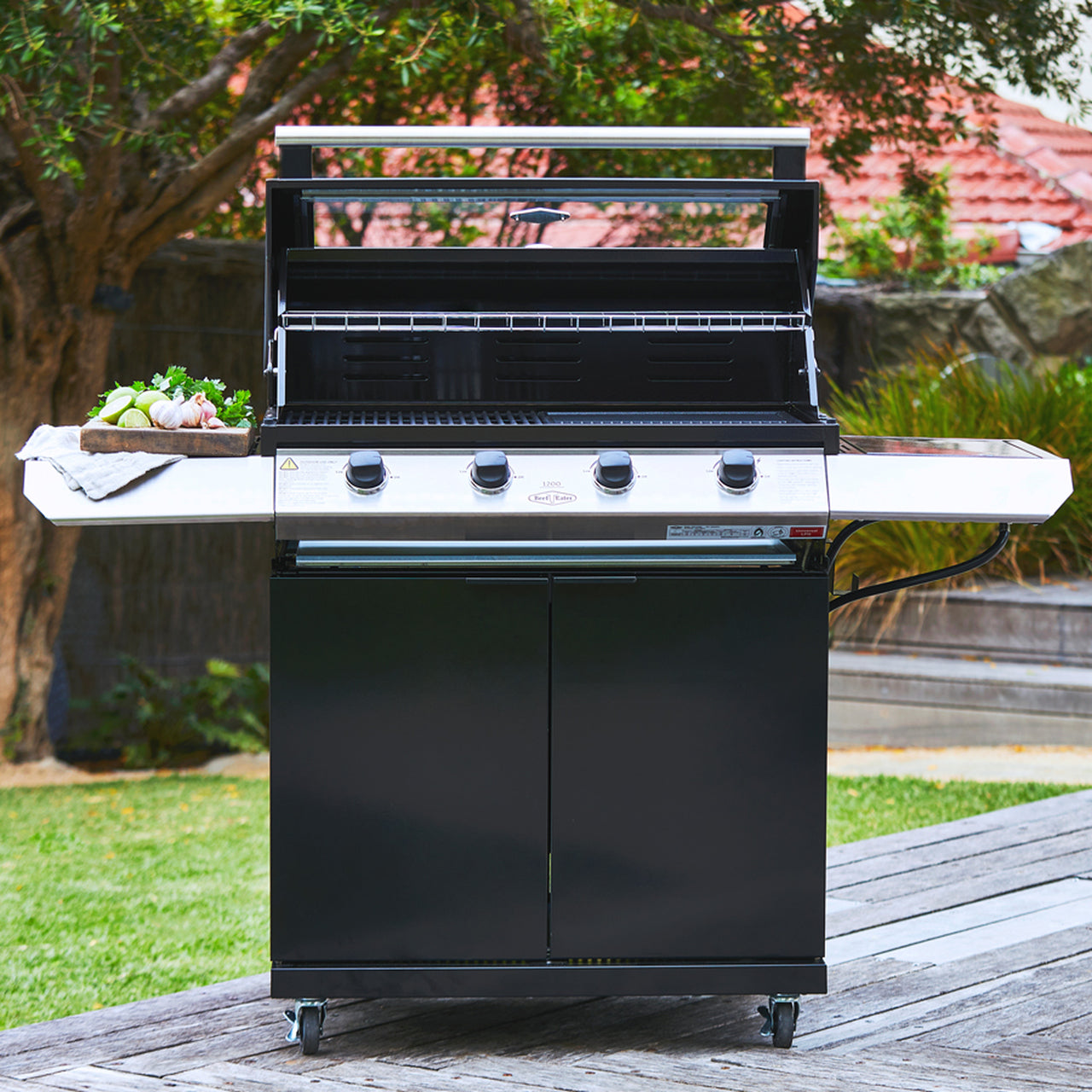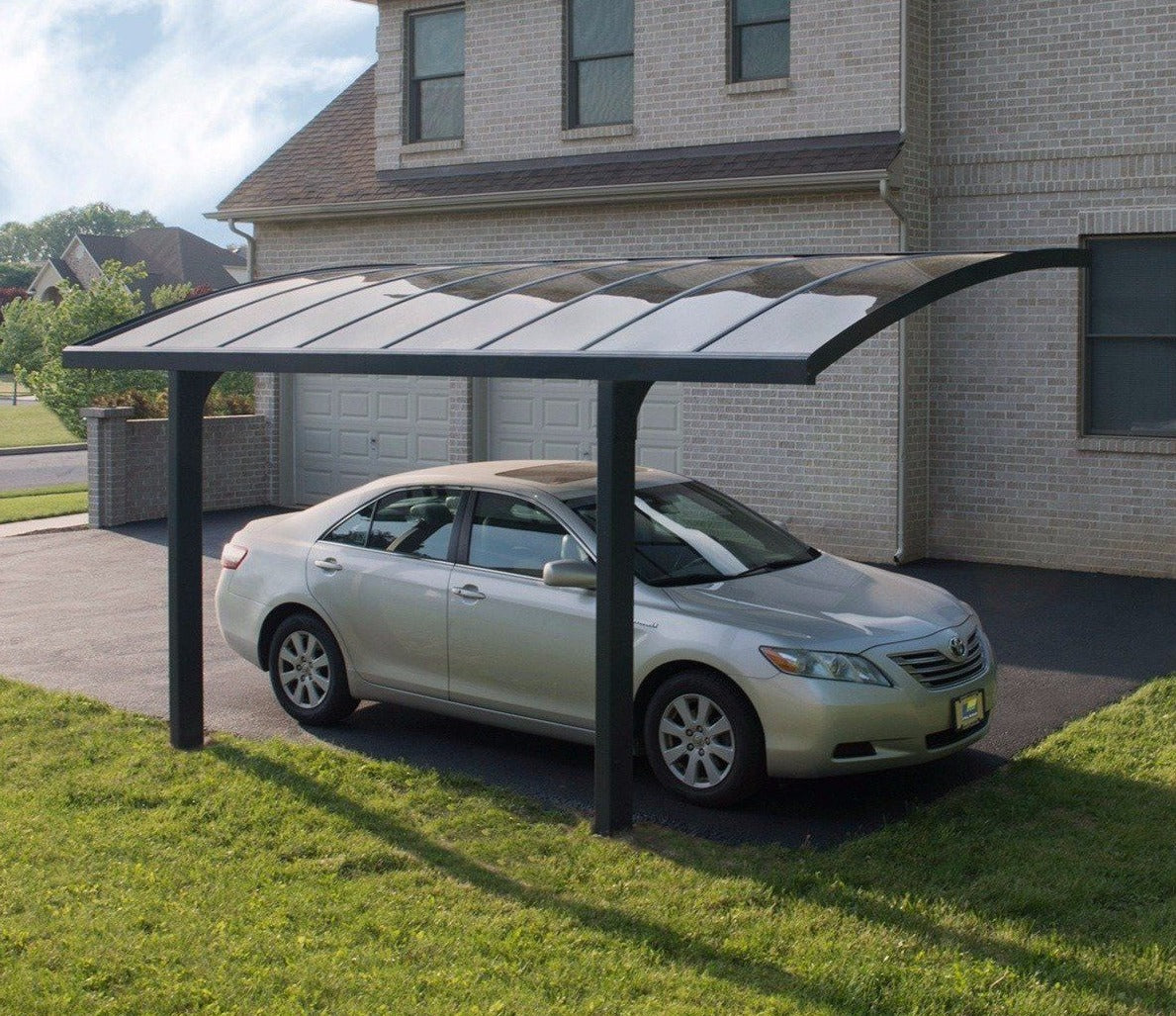Small Polycarbonate Greenhouse Ideas: Your Complete Guide to Choosing the Perfect Greenhouse
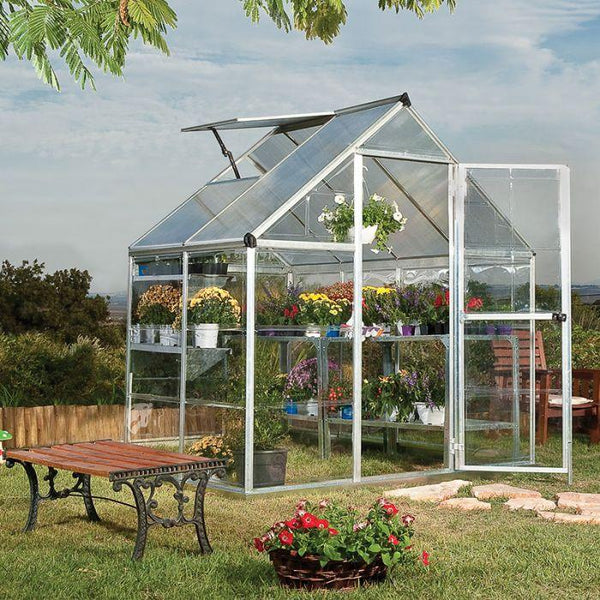
If you've ever looked at your small garden and thought, "I'd love to grow tomatoes in February" or "wouldn't it be brilliant to have fresh herbs all winter," you're not alone. Loads of UK gardeners are turning to small polycarbonate greenhouse ideas to make year round growing a reality, even when space is tight. Whether you've got a compact patio, a modest back garden, or just a sunny corner by the shed, there's a greenhouse solution that'll work for you.
The thing is, polycarbonate greenhouses have become incredibly popular across Britain for good reason. They're tougher than glass, lighter on the wallet, and honestly, they handle our unpredictable weather like champions. From those sudden April frosts to August downpours, a well-chosen polycarbonate greenhouse keeps your plants protected whilst letting in all the light they need.
In this guide, we'll walk through everything you need to know about choosing the right greenhouse for your space. You'll learn about different sizes (from bijou balcony options to more generous garden models), essential features to look for, creative placement ideas, and how to get the most from your investment. We've also handpicked some brilliant examples that work beautifully in UK gardens, so you can see what's actually available rather than just dreaming about hypotheticals.
Whether you're after a spot to start seedlings in spring, extend your growing season through autumn, or even cultivate exotic plants that need a bit of cosseting, the right small polycarbonate greenhouse can make it happen.
Why Choose a Polycarbonate Greenhouse for Your Small Garden?
When you're shopping for a greenhouse, you'll come across three main glazing options: glass, polythene, and polycarbonate.
Whilst glass has that traditional appeal and polythene is budget-friendly, polycarbonate hits a sweet spot that makes it ideal for most UK gardeners, especially if you're working with limited space.
First off, polycarbonate is virtually unbreakable. If a football comes flying over the fence or we get one of those surprise hailstorms, you won't be sweeping up shattered panels. This makes it safer around kids and pets, and honestly, it's just one less thing to worry about.
The panels are also significantly lighter than glass, which means the frame doesn't need to be as heavy-duty. That keeps costs down and makes installation much easier if you're doing it yourself.
The insulation properties are where polycarbonate really shines. Twin wall polycarbonate panels (which most quality greenhouses use) create an air gap that traps heat far better than single layer glazing. During those chilly British nights, this extra insulation can mean the difference between thriving plants and frost-damaged seedlings.
You're not going to get tropical temperatures without heating, but you'll definitely notice your greenhouse staying several degrees warmer than a glass equivalent.
Another brilliant feature is how polycarbonate diffuses light. Rather than direct beams that can scorch delicate leaves, the panels scatter sunlight evenly throughout the space. Your plants get consistent light from all angles, which encourages healthier, more balanced growth.
The UV protection built into quality polycarbonate also filters out harmful rays whilst letting through the wavelengths plants actually need for photosynthesis.
Maintenance is refreshingly simple.
Unlike glass that shows every water spot and cobweb, polycarbonate is more forgiving. A occasional rinse with soapy water keeps it clean, and you don't need to worry about putty degrading or seals failing like you might with older glass structures. Most polycarbonate greenhouses will give you 15 to 20 years of solid service with minimal fussing.
For hobby gardeners who want reliable greenhouse growing without the faff and expense of glass, polycarbonate just makes sense. It's practical, affordable, and performs brilliantly in our unpredictable climate.
Getting to Grips with Small Greenhouse Sizes: Finding Your Perfect Fit
Choosing the right size greenhouse is probably the most important decision you'll make. Too small and you'll be frustrated within a season. Too large and you might struggle to fill it (or find space in your garden). Let's break down what works for different situations.
Compact Options (4x6 to 6x6)
If you're working with a small urban garden, a patio, or even a balcony, compact 4x6 greenhouses to 6x6 greenhouses can be absolutely brilliant. Don't let the modest footprint fool you, these can be surprisingly productive.

A 6x4 model, like the Hybrid Aluminium Silver Frame 6x4 Polycarbonate Greenhouse from Canopia by Palram, gives you just enough room to work comfortably whilst fitting into tight spaces. The aluminium frame keeps everything lightweight and rust-resistant, which matters when you're positioning it on a patio or balcony. The adjustable roof vent helps manage temperature on warm days, and the lockable door gives you peace of mind if you're growing anything particularly precious.
What can you actually grow in something this size? More than you'd think. Think of it as your seedling propagation station in spring, a haven for tomatoes and peppers in summer, or a winter home for tender herbs like basil and coriander. Vertical growing is your friend here. Install some shelving along one side for seed trays and small pots, use the floor space for larger containers, and hang baskets from the roof supports for trailing plants like strawberries.
Medium Small Greenhouses (6x8 to 8x12)
Once you move into the 6x8 greenhouse and 8x12 greenhouse range, you're entering proper productive territory. These sizes suit most suburban back gardens beautifully, giving you enough space to grow a meaningful amount of food or maintain a diverse plant collection.
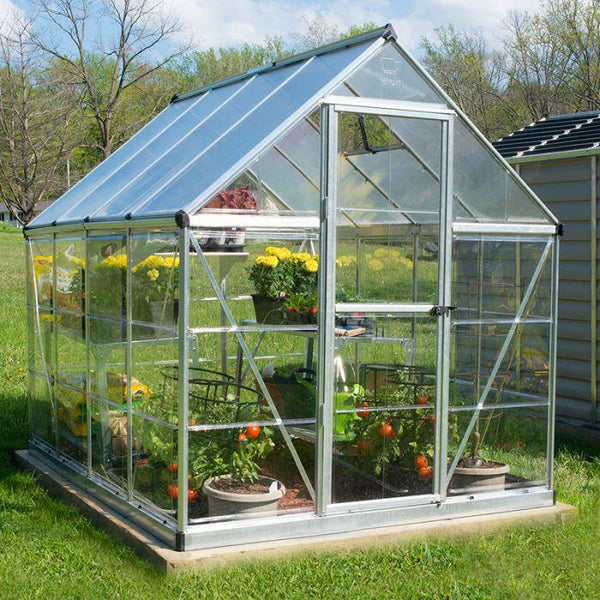
A 6x8 greenhouse (that's 1850mm wide by 2470mm long) hits that sweet spot for many gardeners. The Hybrid Aluminium Frame 6x8 Silver Polycarbonate Greenhouse demonstrates what this size offers. You've got room for shelving along both sides, a central growing area for taller plants, and still enough space to actually work comfortably. Twin wall polycarbonate provides excellent insulation for year-round use.
In a 6x8, you can realistically grow 10-12 tomato plants in the ground or large containers, plus have shelving for dozens of smaller pots with herbs, chillies, or flowering plants. There's space for a small potting bench, which honestly makes such a difference when you're pricking out seedlings or taking cuttings. You can store bags of compost inside during winter without feeling cramped.
If you've got the room and the ambition, a 8x12 takes things further. This length gives you proper zoning options. You might have a warm, humid section for tropical plants at one end, a cooler area for hardy salads in the middle, and a potting station at the entrance. It's enough space to supply a family with tomatoes, cucumbers, peppers, and salad leaves throughout the growing season, with room left over for flowers or experimental crops.
The key with these medium sizes is planning your layout before you start filling it with plants. Measure your shelving, leave pathways wide enough to manoeuvre a watering can, and think about access to vents and doors. A well organised 6x8 will outperform a chaotic 6x14 every time.
Essential Features to Look for in a Small Polycarbonate Greenhouse
Not all greenhouses are created equal, even when they're the same size. The features and materials make a huge difference to how well it performs and how long it lasts. Here's what to prioritise.
Frame Materials: Aluminium vs Resin
The frame is basically the skeleton of your greenhouse, so it needs to be sturdy and durable. You'll typically choose between aluminium and resin frames, and both have their merits.
Aluminium frames are lightweight but strong, and they won't rust even in our damp climate. They're perfect for greenhouses you might want to move eventually, and they keep the overall weight down if you're placing the structure on decking or a patio. The slim profile of aluminium also maximises the glazed area, letting in more light. Most aluminium framed greenhouses come with a powder coated finish that stands up to weather beautifully.
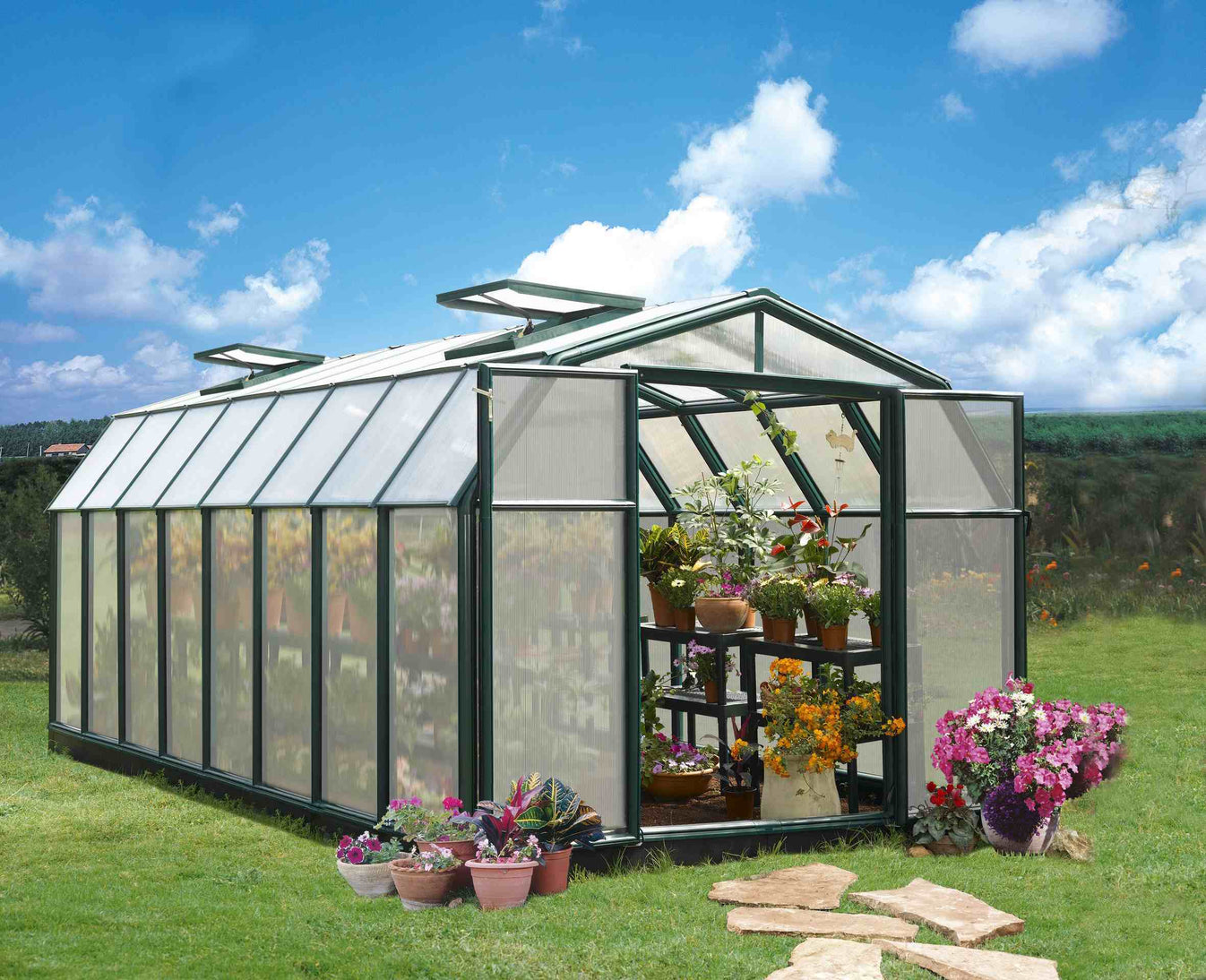
Resin frames, like you'll find on the Rion Hobby Gardener Resin Frame 8ft x 16ft Polycarbonate Greenhouse, offer exceptional weather resistance and are completely maintenance-free. They won't corrode, rot, or need painting. Resin is also a better insulator than metal, which helps maintain stable temperatures inside. The trade off is that resin framed structures are typically chunkier and heavier, which makes them more permanent installations.
For most small greenhouses, aluminium offers the best balance of strength, weight, and cost. If you're in an exposed location with harsh weather, or if you simply want something that'll stand there for decades without any attention, resin is worth considering.
Greenhouse Ventilation Systems
This is non-negotiable. Without proper ventilation, your greenhouse will become a humid, overheated disaster on warm days, even in Britain. Adequate airflow prevents fungal diseases, controls temperature, and stops your plants from literally cooking.
At minimum, look for adjustable roof vents. These let hot air escape from the highest point where it naturally accumulates. The best systems have vents you can prop open to different angles depending on conditions. Some come with automatic openers that use wax cylinders to open and close based on temperature, which is brilliant if you're at work all day.
Cross ventilation is even better. This means having vents or openings at different heights and on opposite sides of the greenhouse, creating airflow that pulls fresh air through. On really hot days, you might open the door as well to get a proper through breeze.
Don't underestimate how much ventilation you'll need. British summers can be surprisingly fierce inside a greenhouse, and even mild days can push temperatures higher than ideal for many plants.
Door Configurations
Doors might seem like an afterthought, but they matter more than you'd think. Single doors on small greenhouses save space and work fine if you're just carrying pots and watering cans. Double doors give you much better access if you're moving larger items like bags of compost, wheelbarrows, or big planters.
Width is important too. Make sure you can actually get through the door whilst carrying something awkward. A door that's too narrow means you'll be doing that frustrating shuffle where you're trying not to knock over seedlings with your elbow.
Lockable handles are worth having, even in a secure garden. They stop the door blowing open in strong winds and give you somewhere to attach a proper lock if needed. Some gardeners grow quite valuable plants or keep tools in their greenhouse, so security isn't trivial.
Foundation and Base Options
A greenhouse is only as good as what it sits on. You need a level, stable base that'll stop it shifting or sinking over time.
For smaller greenhouses, a base of paving slabs works brilliantly. Lay them on levelled ground with a bit of sand underneath, make sure they're properly flat, then position your greenhouse on top. This gives you a solid surface to work on and prevents weeds growing up through the floor.
Gravel is another good DIY option. Create a frame from treated timber, level the ground, lay weed membrane, then fill with gravel or crushed stone. It drains well and provides a stable surface.
For permanent installations, a concrete base is ideal but definitely overkill for most small greenhouses. It's expensive and time consuming, though it does give you a completely level, permanent surface.
Many modern greenhouses come with anchoring systems, metal stakes or ground anchors that secure the frame to the ground. In exposed or windy areas, use them. A greenhouse sailing across the garden during a storm isn't just annoying, it's dangerous.
Creative Small Polycarbonate Greenhouse Ideas for UK Gardens
Once you've got your greenhouse, the fun really begins. Let's look at how to make the most of it throughout the year and fit it beautifully into your garden.
Space Maximising Layout Ideas
Small greenhouses demand smart organisation. Every centimetre counts, so think vertically and creatively.
Install shelving along one or both sides, depending on your greenhouse width. Wire mesh shelves work better than solid ones because they let light through to plants below. Tiered arrangements are perfect for seedlings and small pots, giving you three or four levels of growing space in the footprint of one shelf.
Hanging baskets suspended from the roof supports add another growing layer without using floor space. They're perfect for trailing plants like cherry tomatoes, strawberries, or cascading flowers. Just remember they'll drip when watered, so position them carefully.
Corner spaces often go to waste. Use them for tall, narrow shelving or stack pots vertically with a plant tower. You can even train climbing plants like cucumbers up strings attached to the roof structure, maximising vertical space.
Position your greenhouse thoughtfully in the garden too. East-west orientation gives you maximum light, but sometimes you're constrained by space. Near a garden shed works well because you've got tools and supplies close by. Some gardeners tuck their greenhouse into a corner where fences provide wind protection, which can extend the growing season slightly.
A greenhouse can actually be a lovely focal point. Paint the frame a colour that complements your garden, surround the base with herbs or flowers, or use it as an anchor point for a kitchen garden layout.
All Year Round Growing Plans
The beauty of a greenhouse is turning our six-month growing season into twelve months of productivity.
Spring is all about getting ahead. Start your tomatoes, peppers, and aubergines in February or March when outdoor beds are still frozen. Prick out flower seedlings so they're ready to plant out in May. You can even grow early salads like lettuce and radishes whilst waiting for the weather to improve outside.
Summer brings the main event. This is when your greenhouse earns its keep growing heat-loving crops that struggle outdoors in Britain. Tomatoes, cucumbers, peppers, chillies, and aubergines all thrive under cover. The consistent warmth and protection from rain mean fewer diseases and much better yields than outdoor growing.
Autumn is about extending the season. Keep your tomatoes cropping into October or even November. Start winter salads like rocket, mizuna, and winter lettuce. Bring tender perennials inside before the first frost.
Winter might seem quiet, but there's still plenty to do. Hardy salads will grow slowly but surely. You can force rhubarb for early spring crowns. Overwinter tender plants like pelargoniums and fuchsias that would otherwise need to come indoors. The greenhouse acts like a massive cold frame, protecting plants from the worst weather whilst keeping them dormant until spring.
Combining with Other Garden Structures
Your greenhouse doesn't exist in isolation. Think about how it works with the rest of your garden.
A garden shed nearby is incredibly practical. You store tools, pots, and compost there, then it's just a few steps to your greenhouse. Some gardeners create a dedicated growing area with greenhouse, shed, and raised beds all clustered together, basically making a productive hub.
Consider adding a potting bench just outside the greenhouse door. You can work in natural light and fresh air, then move seedlings inside when you're done. A simple shelf under the eaves of a shed or a fold down table works perfectly.
Raised beds adjacent to the greenhouse create a natural progression. Harden off seedlings in the greenhouse, then plant them out into nearby beds. You might even run irrigation from a water butt positioned between the greenhouse and beds.
The greenhouse can be part of a kitchen garden design, positioned centrally with paths radiating out to vegetable beds, herb gardens, and fruit areas. This makes the most sense if you're growing food seriously.
DIY Enhancements and Customisation
Even a basic greenhouse like the Small Plant Inn Polycarbonate Greenhouse can be enhanced with some simple DIY additions. This compact model is ideal for urban gardens and balconies, and it's perfect for customising to your specific needs.
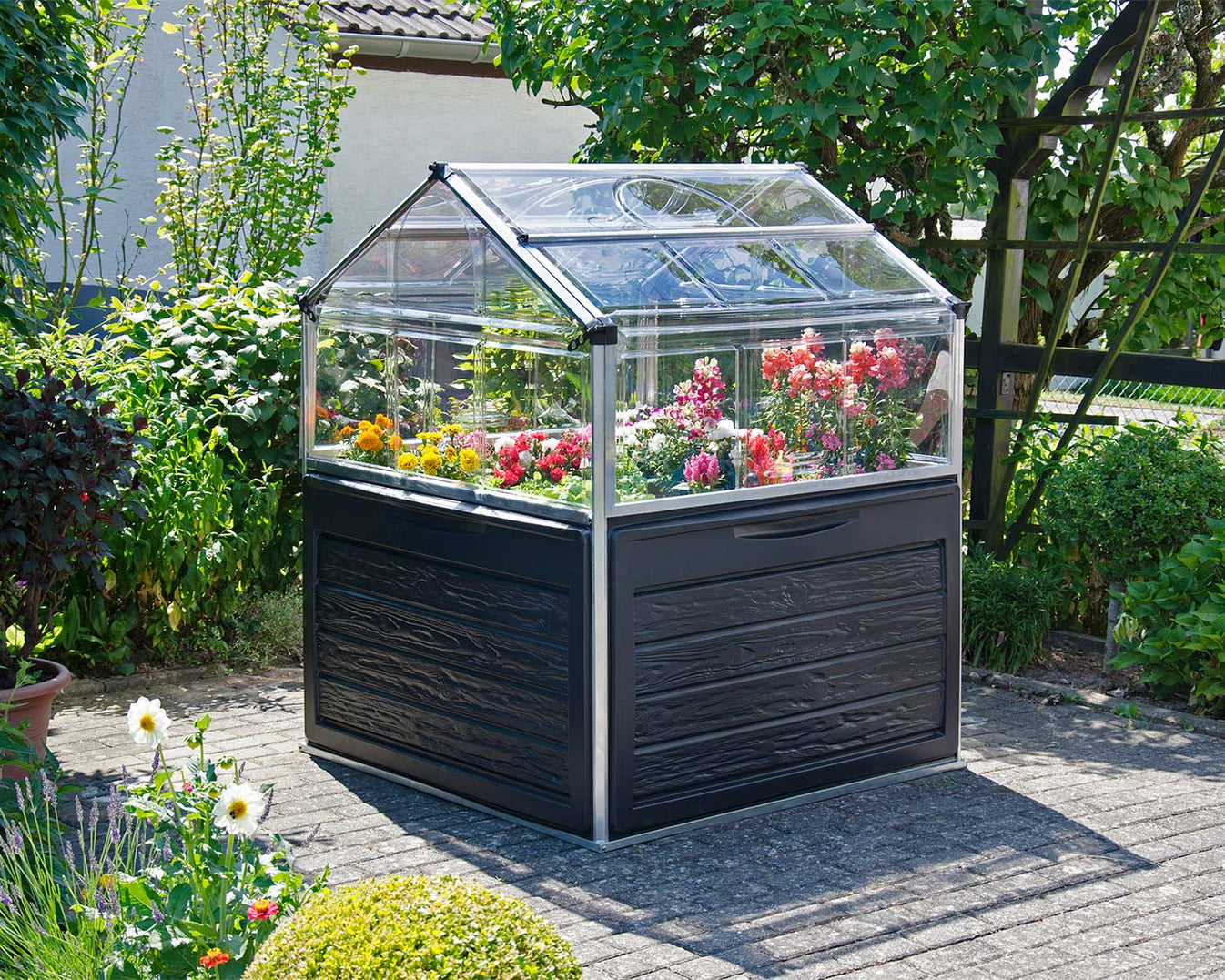
Automatic vent openers are a game changer if you're out during the day. These ingenious devices use temperature sensitive wax that expands to push the vent open when it gets warm, then contracts to close it again when it cools down. No batteries, no electricity, just physics doing its thing. They cost around £20-30 and install in minutes.
Water collection is brilliant for sustainable growing. Position a water butt to catch runoff from the greenhouse roof. You'll be amazed how much you collect, and rainwater is better for plants than tap water anyway. A simple gutter and downpipe arrangement feeding into a butt gives you free irrigation.
Custom shelving from reclaimed wood lets you create exactly the configuration you need. Measure carefully, use treated timber or paint regular wood with exterior paint, and make sure everything is secure. Build narrow shelves for seed trays, deeper ones for larger pots, and leave gaps where you need floor space for tall plants.
A min-max thermometer tells you the temperature range inside your greenhouse. This is genuinely useful information, especially in spring and autumn when you're wondering if it's safe to put tender plants out. They're cheap and sit on a shelf, giving you readings at a glance.
Shade cloth becomes essential in summer. Even in Britain, greenhouses can overheat. Special greenhouse shade fabric reduces light intensity whilst maintaining airflow. Drape it over the roof or attach it to the inside, then remove it in autumn when you want maximum light again.
Choosing Between Green, Silver, and Grey Polycarbonate Greenhouses
Frame colour might seem superficial, but it affects how your greenhouse looks in the garden and, to some extent, how it performs.
Silver or aluminium coloured frames are the most traditional and most common. They're neutral, unobtrusive, and reflect light rather than absorbing it, which can help with temperature management on hot days. Silver frames suit any garden style, from cottage gardens to contemporary spaces.
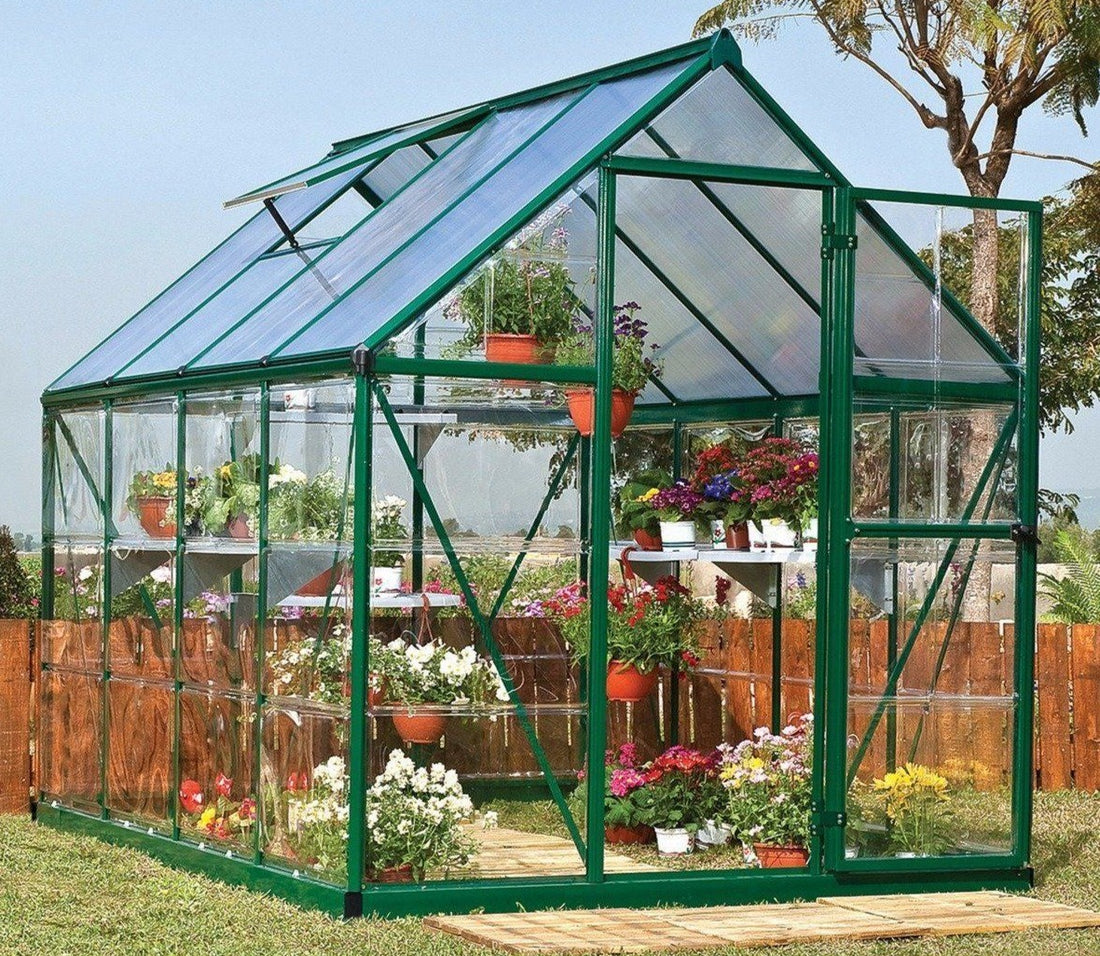
Green frames, like those on the Hybrid Aluminium Frame 6x8 Green Polycarbonate Greenhouse, blend beautifully into garden settings. The greenhouse becomes part of the landscape rather than a stark structure. If you've got green garden furniture, painted sheds in heritage colours, or just want something that feels organic, green is lovely. The darker colour does absorb slightly more heat, which can be beneficial in cooler months but might require more ventilation in summer.
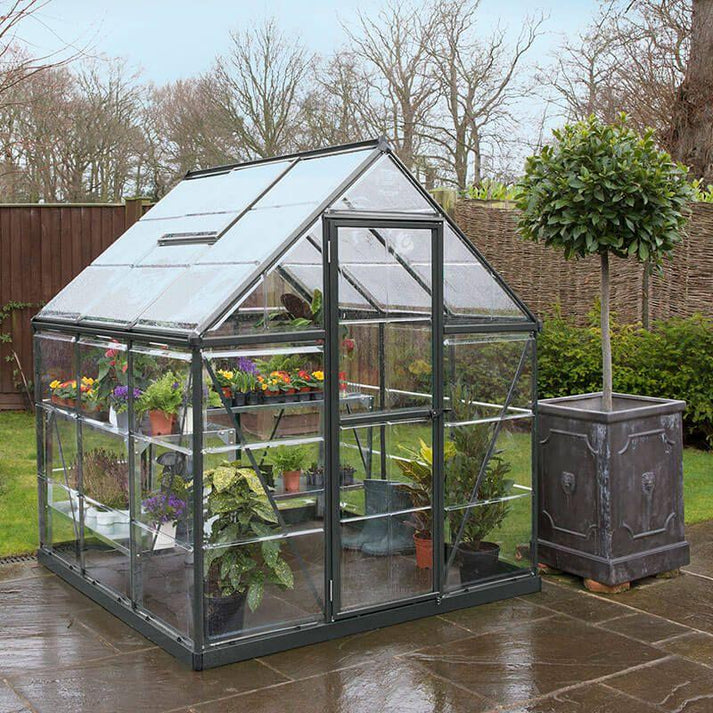
Grey frames offer a contemporary middle ground, as seen on the Hybrid Aluminium Frame 6x8 Grey Polycarbonate Greenhouse. Grey suits modern garden designs brilliantly, especially if you've got grey paving, rendered walls, or contemporary fencing. It's sophisticated without being stark, and pairs beautifully with both natural wood and metal garden features.
Light transmission is virtually identical across all frame colours, the polycarbonate panels matter far more than the frame. Choose based on aesthetics and what works with your existing garden features.
Think about what's already in your garden. If your shed is painted sage green, a green greenhouse creates a cohesive look. If you've got anthracite patio furniture and grey composite decking, a grey greenhouse ties everything together. Silver works anywhere, which is why it remains so popular.
Top Brands: Why Canopia by Palram Greenhouses Stand Out
When you're investing in a greenhouse, brand reputation matters. You want something that'll last, backed by a company that stands behind their products.
Canopia by Palram has become one of the most trusted names in UK greenhouse manufacturing, and there are solid reasons for that. The company has been producing outdoor structures for decades, starting with polycarbonate panels and expanding into complete greenhouse systems.
Their quality standards are consistently high and it is why we carry them on our website. The aluminium frames use corrosion resistant materials designed specifically for outdoor use. The twin wall polycarbonate comes with UV protection that prevents the yellowing and degradation you see with cheaper plastics after a few years. Joints and fittings are engineered to handle British weather, particularly wind and rain.
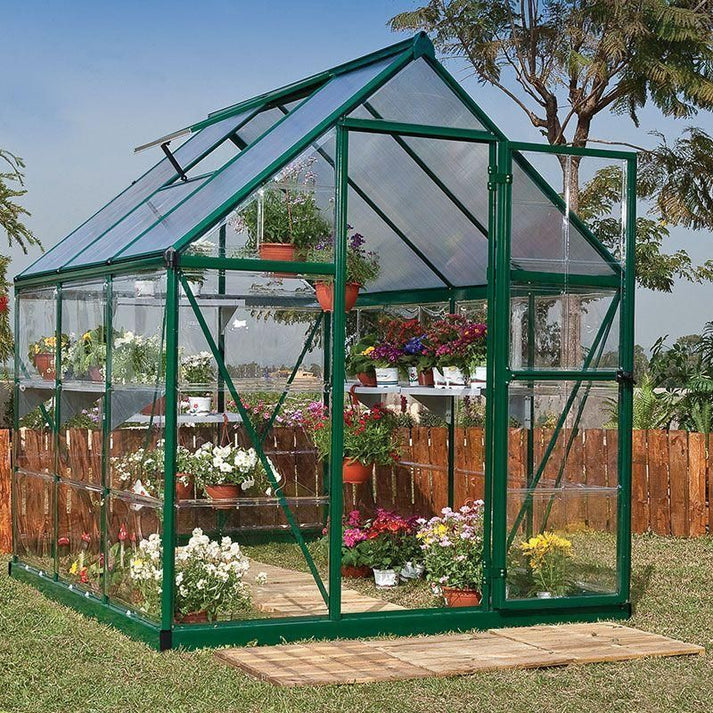
The Hybrid Aluminium Frame 6x6 Green Polycarbonate Greenhouse shows what Canopia does well. It's designed for UK conditions, handles year round use, and comes with features like adjustable vents and lockable doors as standard rather than expensive add-ons.
Warranty coverage with Canopia is reassuring. They typically offer extended warranties on frames and panels, showing they're confident in longevity. If something does go wrong, replacement parts are actually available, unlike some cheaper brands where you're on your own after purchase.
The range of sizes and configurations means you can find something that fits your specific garden. From compact models for small spaces to larger structures for serious growers, they've got options. The modular design of many Canopia greenhouses also means you can add extensions later if you catch the greenhouse bug and need more space.
Installation instructions are clear and thorough, with proper diagrams rather than confusing pictograms. Most people successfully assemble these greenhouses themselves with basic tools and a helper. Customer support is UK-based and responsive, which makes a difference when you're stuck on assembly step 23 or need to order a replacement part.
Value for money is where Canopia really shines. They're not the cheapest greenhouses you'll find, but they're competitively priced for the quality you get. When a greenhouse lasts 15-20 years rather than falling apart after five, the initial investment makes sense.
Installation and Maintenance: DIY Greenhouse Plans and Tips
DIY Small Polycarbonate Greenhouse Installation Guide
Most people can assemble a small polycarbonate greenhouse themselves, though honestly, it's much easier with two people. Realistic time expectations are 4-6 hours for a small greenhouse, possibly longer if it's your first one or if you encounter issues with the base.
Tools you'll need are basic: screwdrivers (both flathead and Phillips), an adjustable spanner or set of spanners, a spirit level, a measuring tape, and possibly a rubber mallet for persuading pieces into place. A cordless drill speeds things up but isn't essential.
Site preparation is crucial and worth spending time on. Mark out your greenhouse footprint with string and pegs, then check it's level. A greenhouse on uneven ground will never assemble properly, panels won't fit right, and doors won't close correctly. Use your spirit level religiously.
Lay your base (paving slabs, gravel bed, or whatever you're using) and double-check it's level before you start assembling. Seriously, check it again. An extra ten minutes here saves hours of frustration later.
Read the instructions completely before starting. I know, nobody wants to, but identifying all the parts and understanding the sequence makes assembly flow much smoother. Lay out all the pieces and check everything's there before you begin.
Start with the base frame, get it perfectly square and level, then build upwards. Most greenhouses have numbered or lettered parts, follow the sequence. Don't fully tighten everything until the structure is complete, it's easier to make adjustments if bolts are finger-tight.
Common mistakes include forcing parts that don't quite fit (stop and work out why), not checking square as you go (measure diagonals, they should be equal), and assembling in strong wind (wait for a calmer day, honestly).
Installing polycarbonate panels usually comes last. Handle them carefully, they're flexible but can crack if mishandled. Most systems use special clips or channels to hold panels in place. Work from bottom to top so upper panels overlap lower ones, shedding water correctly.
When to consider professional installation? If you're not confident with DIY, if you have mobility issues that make assembly difficult, or if you've bought a particularly large or complex greenhouse, paying for installation is worth it. Many companies offer this service.
Ongoing Polycarbonate Greenhouse Maintenance Schedule
Polycarbonate greenhouses are low-maintenance, but not no-maintenance. A bit of attention keeps them working brilliantly for decades.
Seasonal cleaning is your main task. In spring and autumn, wash the panels inside and out with warm water and a drop of washing up liquid. A soft brush on an extendable pole reaches the roof without climbing on things. Rinse thoroughly because detergent residue can inhibit light transmission. This removes algae, dirt, and mineral deposits that build up over time.
Clean gutters if your greenhouse has them, especially in autumn when leaves accumulate. Blocked gutters mean water overflowing onto the base or, worse, seeping into joints where it can cause problems.
Check seals and glazing each season. Look for any panels that have come loose or seals that are perishing. Address these quickly before small issues become big ones. Most polycarbonate systems use rubber seals or gaskets that can be replaced if they deteriorate.
Lubricate vents and doors annually with a spray lubricant or light oil. Moving parts that stick will eventually break, and replacements are annoying to source. Spending five minutes with a can of WD40 prevents this.
Winter preparation in UK climate means checking your greenhouse can handle what's coming. Ensure vents close properly (you don't want freezing air blasting your plants all night). Check the structure is secure and well-anchored. Clear snow from the roof after heavy falls, whilst polycarbonate won't shatter like glass, heavy snow can strain the frame.
Remove algae and moss from panels and frame when you spot them. They don't harm the structure but they block light. A soft brush or cloth with soapy water usually shifts them. For stubborn growth, specialist greenhouse cleaner works better than harsh chemicals.
Replacing damaged polycarbonate sections is relatively straightforward. Note which panel is damaged, order a replacement from the manufacturer or a greenhouse specialist, then follow the installation instructions in reverse to remove the old panel and fit the new one. Don't leave damaged panels in place, they compromise insulation and weather protection.
Protecting Your Greenhouse Investment
Anchoring systems matter, especially in exposed locations. The Hybrid Aluminium Frame 6x14 Polycarbonate Greenhouse comes with proper anchoring options because at this size, wind resistance becomes critical. Use all the ground anchors provided, driving them fully into firm soil.
In particularly windy areas, consider additional securing. Heavy duty tent pegs through the base rails work, or concrete blocks attached to the frame inside. It sounds excessive until you see photos of greenhouses that weren't properly secured doing an impression of Dorothy's house in The Wizard of Oz.
Insurance is worth considering if your greenhouse contains expensive equipment or rare plants. Standard home insurance often covers outbuildings up to a certain value, but check your policy. Some garden buildings insurance specifically covers greenhouses, including the contents.
Extending greenhouse lifespan through proper care is mostly about those simple maintenance tasks and protecting it from physical damage. Keep trees and shrubs trimmed back so branches don't fall on it during storms. Don't lean tools or ladders against polycarbonate panels. Store chemicals properly so they don't splash onto panels and cause damage.
With reasonable care, your polycarbonate greenhouse should give you 15-20 years of reliable service, potentially longer. That's a lot of tomatoes, a lot of seedlings, and a lot of gardening joy.
Budget Considerations: Getting the Best Value Small Polycarbonate Greenhouse
Greenhouses represent a significant investment, so understanding what affects pricing helps you make smart decisions.
Small polycarbonate greenhouses start from around the £300 mark for compact models and can go up to £700-800 for larger, feature-rich options. That's a wide range, so what's driving those differences?
Size is the obvious factor. More materials equal higher costs. A 6x4 greenhouse uses less aluminium and fewer polycarbonate panels than a 6x14, so it costs less. But there's not a linear relationship, a greenhouse twice the size doesn't cost twice as much because lots of components (doors, vents, fixings) are similar across sizes.
Materials matter significantly. Higher-grade aluminium with better powder coating costs more but lasts longer. Twin-wall polycarbonate with superior UV protection and better light diffusion is pricier than basic single-wall or lower-grade twin-wall. Resin frames typically cost more than aluminium because of the materials and manufacturing process.
Brand affects pricing. Established manufacturers like Canopia by Palram charge slightly more than unknown brands because you're paying for proven quality, available replacement parts, and customer support. That's not necessarily overpriced, it's value you might appreciate in year five when you need a new door seal and can actually get one.
Features add cost. Automatic vent openers, integrated staging, multiple vents, wider doors, all these increase the price but also increase functionality. Decide which features you'll actually use versus which are nice-to-haves.
Long-term value versus initial cost is worth considering. A £300 greenhouse that lasts five years costs you £60 per year. A £600 greenhouse that lasts 20 years costs £30 per year. The cheaper option isn't always the economical choice.
Running costs for polycarbonate greenhouses are minimal. There's no electricity required for basic models. You might spend a bit on cleaning supplies, occasional seal replacements, or accessories like shade cloth. If you add heating for winter, that's an ongoing cost, but most small greenhouses work fine unheated for British conditions.
Return on investment through home-grown produce is genuinely substantial if you use your greenhouse well. A single tomato plant can produce 5-10 kg of fruit. Bought organic tomatoes cost around £6-8 per kg, so one plant saves you £30-80. With 10-12 plants in a 6x8 greenhouse, you're looking at potentially £300-800 worth of tomatoes alone. Add peppers, cucumbers, herbs, and seedlings you're not buying from garden centres, and a greenhouse can pay for itself within 2-3 years.
Free UK delivery is standard from most reputable retailers, which matters because greenhouses are bulky and shipping costs would be significant. We offer free delivery on all of our Polycarbonate Greenhouses here at Garden & Patio.
Frequently Asked Questions About Small Polycarbonate Greenhouses
Do I need planning permission for a small greenhouse?
Generally, no. In England and Wales, greenhouses fall under permitted development rights as long as they meet certain criteria. They must be less than 2.5 metres high if within 2 metres of a boundary, and the total area of outbuildings shouldn't exceed 50% of the garden area.
There are exceptions. If you live in a conservation area or a listed building, different rules apply and you should check with your local planning authority first. Scotland and Northern Ireland have slightly different regulations.
For most people with a standard suburban garden, a small greenhouse doesn't require planning permission. But if you're uncertain, a quick call to your local council planning department clarifies things. They're usually helpful about these questions.
How long do polycarbonate greenhouses last?
With proper care, expect 15-20 years from a quality polycarbonate greenhouse. The UV protection in good polycarbonate prevents the yellowing and brittleness that plagued older plastics. Aluminium frames don't rust and will outlast the panels.
Eventually, polycarbonate does degrade. You'll notice it becoming more opaque, losing some of that crystal clarity. When that happens, you can usually replace just the panels rather than the entire greenhouse. Frames often last 25-30 years or more.
Cheaper greenhouses with lower grade polycarbonate might only give you 7-10 years before panels need replacing. This is where buying quality pays off. All of our greenhouses come with extensive warranty.
Can I use a small polycarbonate greenhouse year round?
Absolutely. That's one of their great strengths. The twin wall polycarbonate provides enough insulation for year-round use in the UK without heating for many crops.
In winter, you can grow hardy salads, overwinter tender perennials, and start seeds earlier than outdoor sowing. If you add a basic electric heater to keep temperatures just above freezing, you can grow much more. Heating to 7-10°C opens up growing Mediterranean vegetables through winter.
Summer requires good ventilation to prevent overheating, but with vents open and possibly shade cloth, you'll maintain ideal growing conditions for heat-loving crops.
The key is understanding seasonal management, what works unheated in January versus July, and adjusting your growing plans accordingly.
What's the difference between single and twin wall polycarbonate?
Single wall polycarbonate is one solid sheet. It's cheaper, lighter, and lets in marginally more light. But it provides minimal insulation, it's not much better than a plastic greenhouse.
Twin wall polycarbonate consists of two layers with an air gap between them. This air gap creates insulation, keeping heat in during cold nights and preventing excessive heat build-up during warm days. The double layer also diffuses light better, reducing harsh shadows and hot spots.
For UK growing conditions, twin wall is worth the extra cost. The insulation extends your growing season by weeks at each end and provides better year-round growing conditions.
Some premium greenhouses use 6mm or even 10mm twin-wall panels for maximum insulation. Standard is 4mm, which suits most needs perfectly.
How do I prevent my greenhouse from blowing away?
Proper anchoring is essential. Most greenhouses come with ground anchors or stakes, use all of them. Drive them fully into firm ground, not just pushed in partway.
The base is your first defence. A solid base (paving slabs, gravel bed, or concrete) adds weight and stability. Anchor the greenhouse frame to this base using the provided fixings or additional bolts.
In exposed locations, consider extra measures. Some people place heavy paving slabs inside around the perimeter. Others use auger style ground anchors (the type used for securing sheds) for extra security.
Don't rely on the weight of soil or plants inside to hold it down. Wind gets underneath and lifts, and an empty greenhouse in March before planting is vulnerable.
If you experience very strong winds and the greenhouse seems at risk, opening doors and vents can actually help by letting wind pass through rather than creating uplift. But proper anchoring from the start is your real protection.
What can I grow in a small polycarbonate greenhouse?
The list is extensive and exciting. Vegetables like tomatoes, peppers, chillies, cucumbers, and aubergines thrive under cover and give much better yields than outdoor growing in Britain. You can grow crops that struggle outdoors entirely, like melons or certain squash varieties.
Herbs benefit hugely from greenhouse protection. Basil, coriander, and parsley grow stronger and last longer under cover. Mediterranean herbs like rosemary and thyme overwinter better with that extra protection.
Flowers for cutting, especially sweet peas started early, zinnias, and dahlias, all do brilliantly. You can start bedding plants from seed much earlier and cheaper than buying plugs.
Seedling propagation might be the most valuable use. Starting your entire vegetable garden from seed under glass in spring gives you healthy plants and saves a fortune compared to buying from garden centres.
Space planning depends on your greenhouse size, but even compact models can accommodate 40-50 seedling trays on shelves, plus 6-8 larger plants on the floor or in growing bags.
Succession planting keeps your greenhouse productive year-round. As summer tomatoes finish, plant winter salads. When spring seedlings transplant out, fill the space with tender plants that need summer protection.
Making the Most of Your Small Polycarbonate Greenhouse Journey
Choosing and using a small polycarbonate greenhouse genuinely changes how you garden in Britain. The ability to start seeds in February instead of May, to grow tomatoes that actually ripen, to have fresh herbs in December, these things shift your entire growing year.
The greenhouses we've looked at offer something for every situation and budget. Compact models fit onto balconies and tiny patios, giving urban gardeners a proper growing space. Medium sizes suit suburban gardens perfectly, providing enough room for serious food production without dominating the landscape.
Polycarbonate construction means you're getting durability, insulation, and safety without the fragility and expense of glass. Modern frames, whether aluminium or resin, handle British weather confidently and need minimal maintenance. Good ventilation systems, lockable doors, and twin-wall panels come as standard features rather than expensive upgrades.
The key is choosing the right size for your space and ambitions. Start with what fits comfortably in your garden and matches your current gardening enthusiasm. You can always upgrade later if you catch the greenhouse bug, which most people do once they experience that first crop of sun-ripened tomatoes or harvest salad leaves whilst snow covers the garden outside.
Installation is manageable for most people with basic DIY skills, especially with a helper and a few hours on a calm weekend. Maintenance is minimal, just seasonal cleaning and keeping an eye on vents and seals. With proper care, your greenhouse will serve you for decades.
Budget options exist, and investing in quality from established brands like Canopia by Palram gives you confidence in longevity and ongoing support. The range available means finding something that suits your specific needs and aesthetic preferences.
Year-round growing in the UK is absolutely achievable with a small polycarbonate greenhouse. You'll extend seasons at both ends, protect tender plants, propagate seedlings, and simply have a lovely space to potter when the weather outside is miserable.
So, whether you're dreaming of fresh tomatoes, wanting to start your entire garden from seed, or just fancy a weather-proof space to nurture plants, there's a small polycarbonate greenhouse that fits your garden and your growing ambitions. With free UK delivery available on quality options, getting started is easier than ever. Your year-round growing adventure is just one greenhouse away.
Chat with our friendly team if you have any questions, and check out our full polycarbonate greenhouse collection here!








